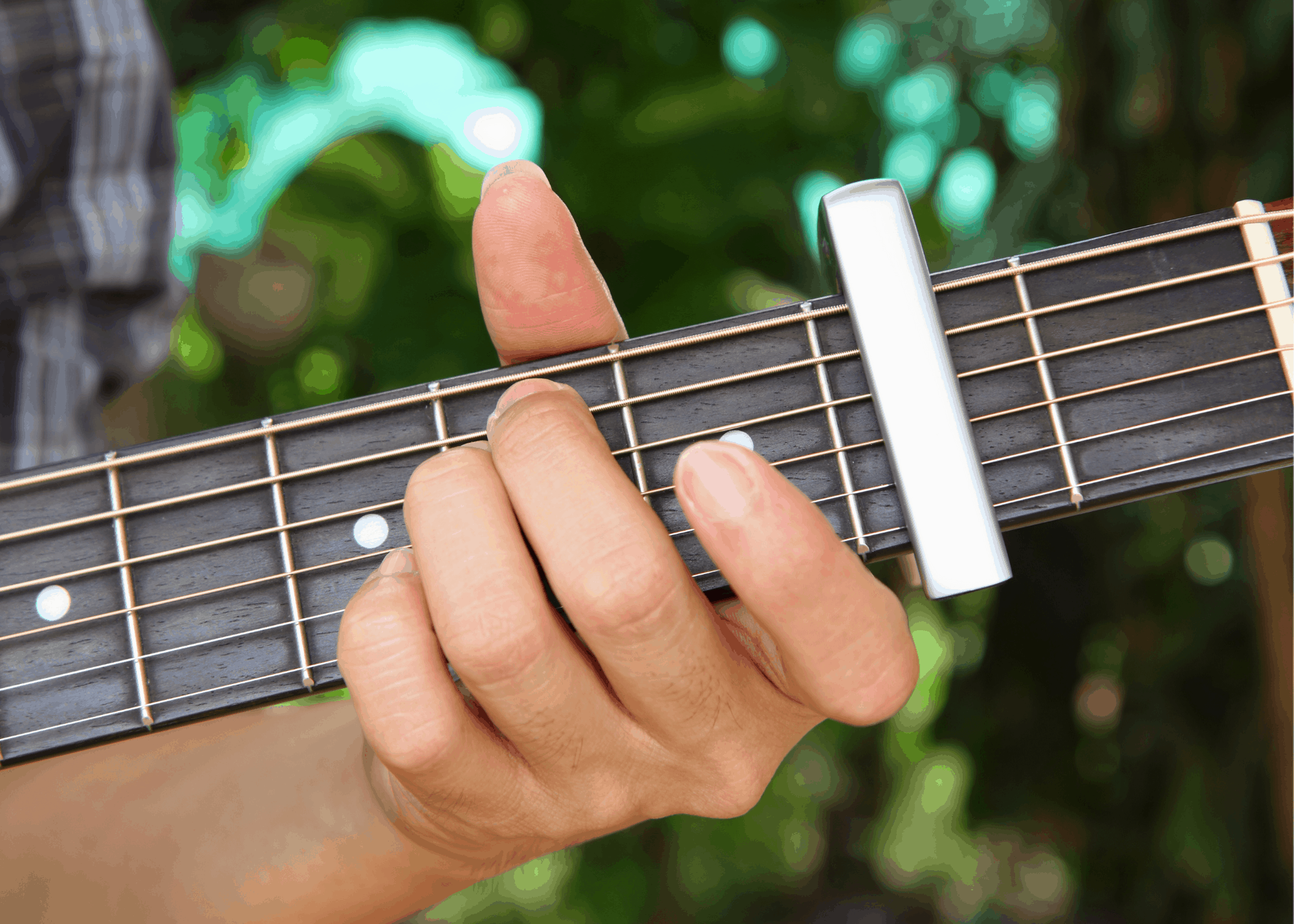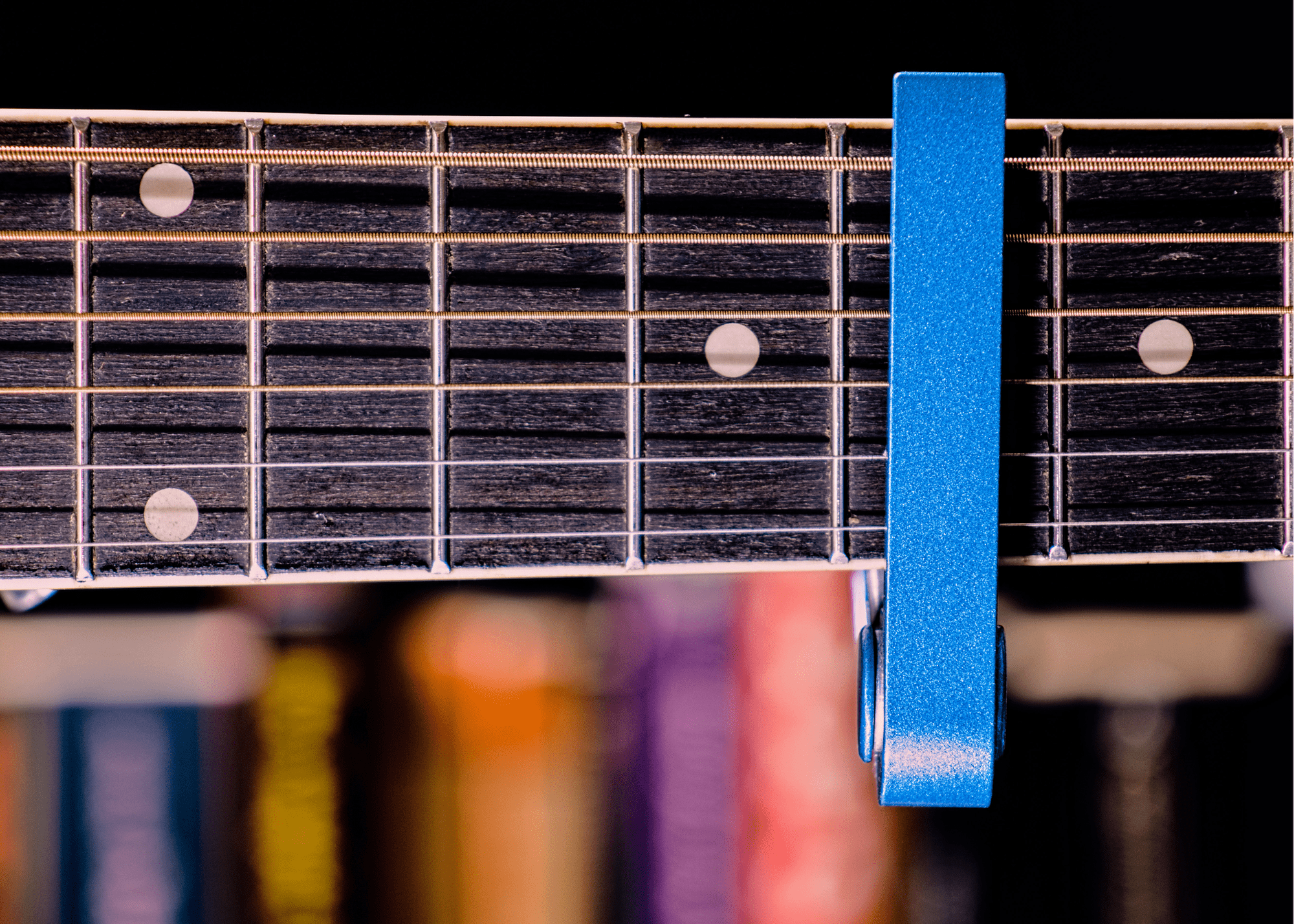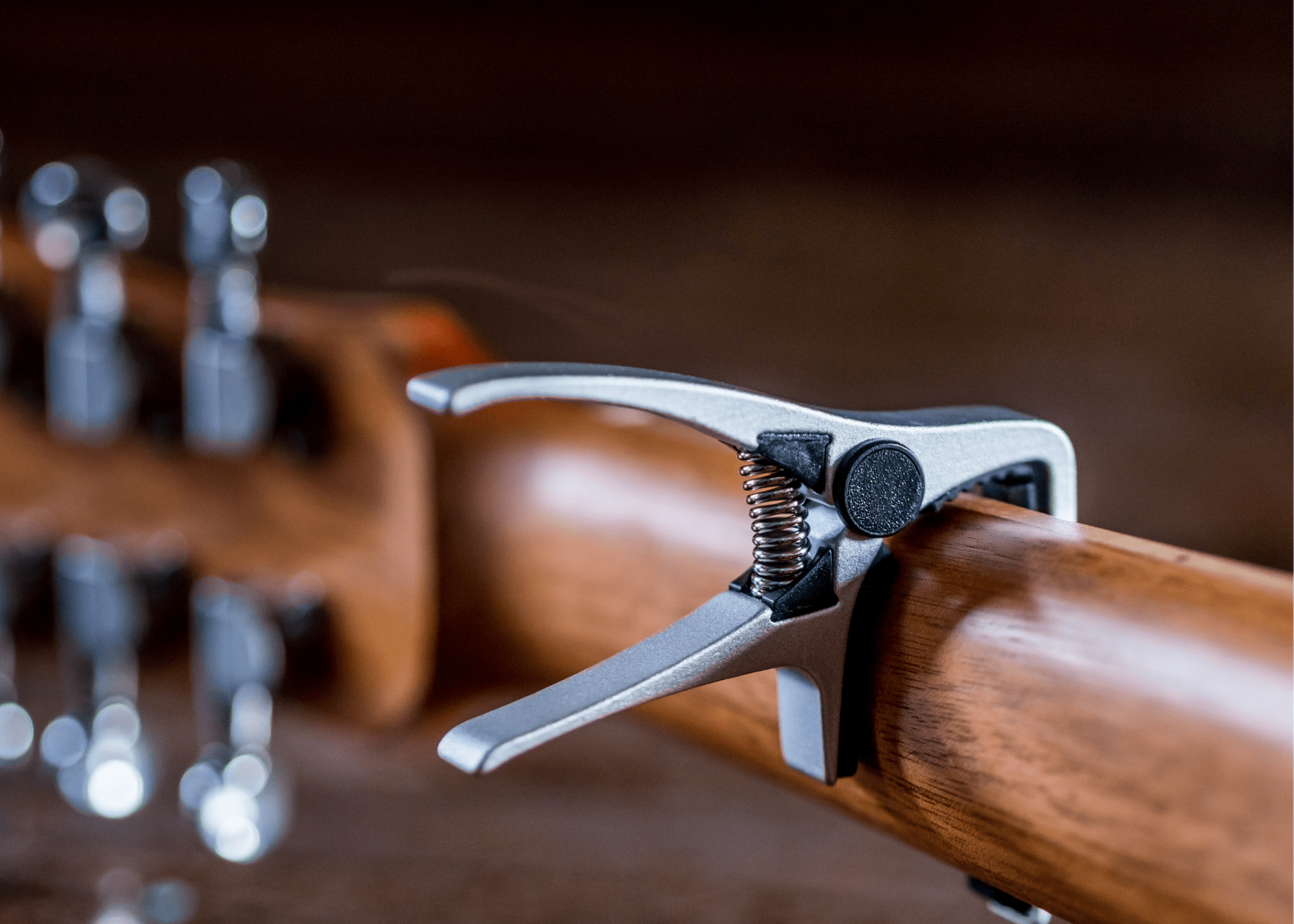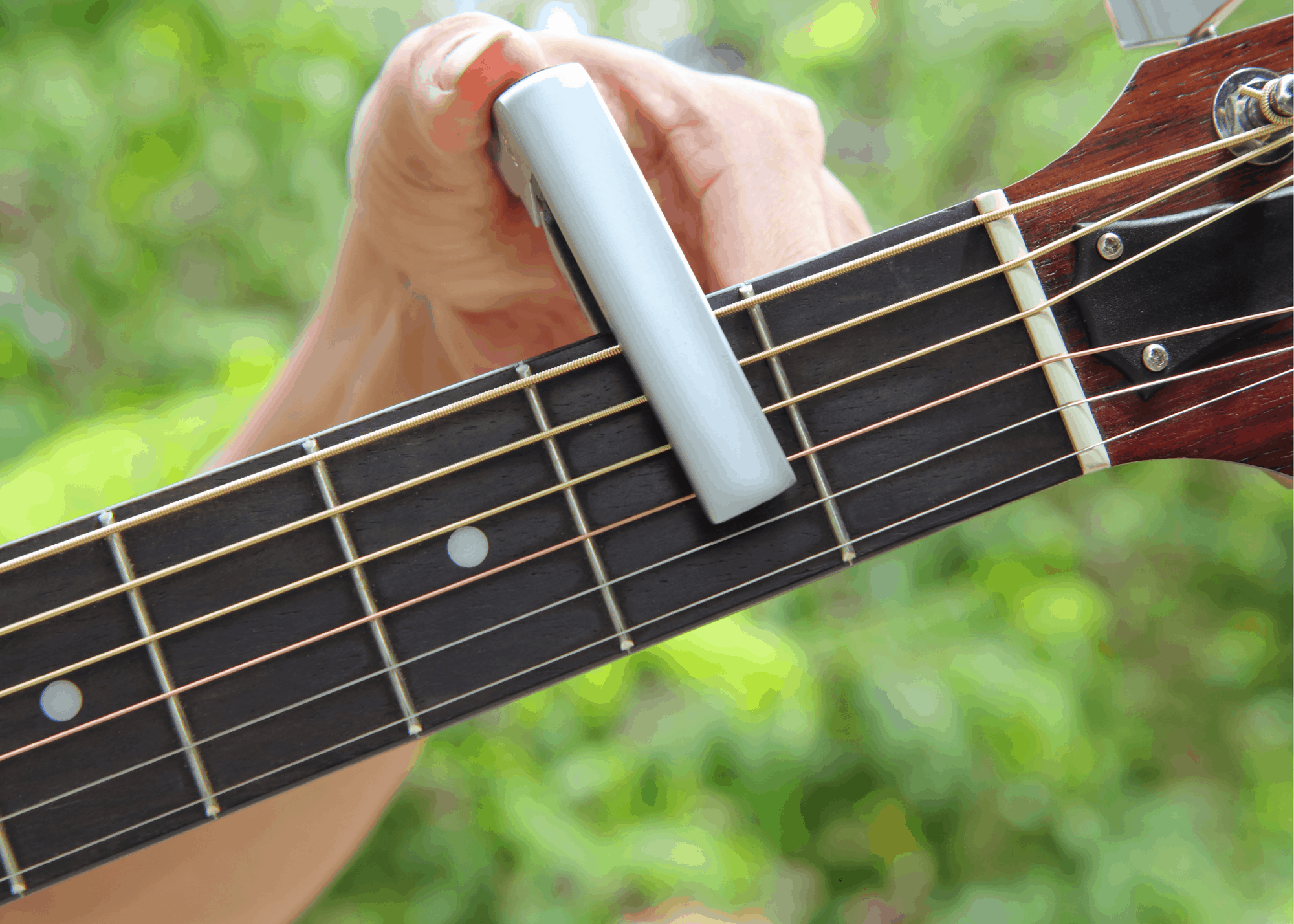What Does A Capo Do On Guitar?
Using a capo is a valuable skill for anyone learning guitar. It's not difficult to learn how to use a capo properly, though there are a few things you need to know to get the maximum benefit from this simple but powerful tool.
So, what does the capo do?
The capo acts as a movable nut. It raises the pitch of the guitar strings as you move it closer to the bridge of the guitar.
Why would we want to do that?
90% of the time it's used to change the pitch of a song up or down to make it easier to sing.
It's not the only way to change the pitch of a song, but it is often the quickest and easiest way.
By learning how to use a capo in this way you'll also be developing the ability to use it for other purposes as well…
Capo Basics: The Movable Guitar Nut
When you play an open chord on the guitar some of the notes are being created by where you put your fingers on the frets. Others are what we call "open". Where the string meets the nut of the guitar is what creates the note… this little white thing the the strings sit on.
If you move the chord up the guitar neck it won't sound right anymore because the open strings didn't change. They’re still making the same note as before where they sit on the nut.
One way to think of a capo is as a kind of movable nut for the guitar. You can put the capo on, for example, the second fret. Then play that same chord up two frets. Now all the open strings will move up to frets also in the chord will sound right.
In this case I'm making a G form of the chord. It’s important that we distinguish between the guitar chord form and the chord sound. In this case they’re one and the same. When I play that G chord without a capo it's both the G chord form and it sounds like a G chord.
Now when I put the capo on the second fret and finger the G chord form it's no longer the sound of a G chord. By moving it up two frets it becomes an A chord.
Up two frets means going from G, to G#, then to A...
Here's another example. Now I'm playing a C chord form that is also a C chord sound. When I put the capo on the second fret I can still play the C chord form, but it's no longer the sound of the C chord. I raised it up one. To become the sound of a D chord.
Pitch

Let’s talk about pitch. When we say we’re raising the pitch of a song what we’re doing is making the sound higher. When you lower the pitch you make the sound lower. For example if I play this note on the guitar (play note) and I want to raise the pitch I'll move my finger up the guitar neck. Now the pitch is going higher.
The same applies when I move my finger in the other direction the pitch goes down. The sound is lower.
Sometimes you'll want to raise or lower the pitch of a song to make it easier to sing. It's common to say, in this situation, that you are changing the “key” of the song.
There's a relationship between the pitch and the key of a song, but not exactly the same thing.
The main thing you want to know right now is that by changing the key of a song you will raising or lowering the pitch.
Raising the Key or Pitch of a Song

This start by using an example of a song that starts with the G chord. For this example will use the G chord, the C chord and the D chord. We could say this song is in the key of G. These three chords can establish the sound of the key of G.
If I wanted to raise the pitch of the song I could use a capo. I can put the cable on the first fret and I would raise the entire pitch of the song by one fret, or one half step. As you may know one fret on the guitar is equal to one half step.
If I put the capo on the second fret I would be raising the pitch of the song by one whole step. Two half steps equal one whole step.
The song is now in the key of A.
If I move the capo up another half step it will now be in the key of A sharp. Another half step and it will be in the key of B.
This is an easy way to raise the pitch of a song if the song is low for the singer’s voice. But what if the song is already too high and you need to make the pitch lower?
Lowering the Key or Pitch of a Song

What we’re going to do is jump down in pitch by changing the chords of the song so that the song is in a much lower key. Then we'll use the capo to refine the change by putting it on one fret at a time until we've raised it to the right key.
This is where a brief lesson in changing the key of a song will come in handy.
A simple definition of the key of a song would be the note or chord that sounds like the tonic or home. In other words, a place of rest on that note or chord. Using notes and chords from the scale for that key established the key.
Let's use the key of G as an example. A song in the key of G would have a melody composed of notes from the G scale. Chords would come from notes from the G scale. It's also common, but not absolute, to begin and end the song on the tonic chord... In this case the G chord.
To jump down to a lower key I would pick a key that's quite a bit lower and still easy to play on guitar. Then I would change all the chords to match the new key. One way to do this would be to count the distance from the old chords to arrive at the new chords.
Here's an example. Let's use a song that in the key of G and uses the G chord, the C chord in the D chord. I want to jump down to the key of D.
Here's a quick review of the musical alphabet.
A - B - C - D - E - F - G
And then starts over again.
We’re going to go down 3 notes. We will be going down from G, to F, E, and arrive at D.
Now for the G chord you would use the D chord instead.
For the original C chord you would countdown three notes…
C, to B, A and then to G.
Now will do the same thing for the final chord in our song… The D chord.
Counting down we go from D, to C, B and arrive at A.
The new chords for our song are the D chord, the G chord, and the A chord.
We can now say we have transposed, or changed, do the key of D.
That's cool. Now we know how to transpose a song.
Now I would test it out and see if in fact this is too low. If it is I would start putting my capo on one fret at a time until it seemed about right.
For example… If I put my capo on the first fret I would now be raising the pitch by one half step. I can also say I've raised the key from D to D sharp.
If I put the capo on the second fret I've raised it up to have steps, or to the key of E.
But what if, after transposing the song to the key of D, it still seems to high?
One of the things I could do is to transpose the song to an even lower key. In this case I could transpose the song to the key of A. For practice let's do that transposing exercise one more time.
Here's the musical alphabet again
A - B - C - D - E - F - G
Starting from the G chord again I could count back six notes to get to A.
Another way to do this would be to count up one note. Since the musical alphabet goes in the cycle counting up one note is the same as counting back six. For me it's easier to count up… So let's do that in this example.
For the original C chord let’s go up one note to D…
For the D chord we’ll go up to E.
The new chords for our song are the A chord, the D chord, and the E chord.
We can now say we have transposed, or changed, do the key of A.
Again I could use my capo to raise from the key of A by half steps until the sound is at the pitch I want.
If I put the capo on the first fret I would raise the pitch by one half step... or to the key of A sharp. If I went with two frets I would be at the key of B.
On the third fret I would be at the key of C. Remember there's only one half step between the B and C.
Changing Keys With A Capo Exercises

It's one thing to understand something intellectually but another to actually use it. Here are three exercises that will help you integrate this understanding. You'll get the chance to play and hear the effect of using a capo.
Exercise #1
Let's start off by playing a simple chord progression. It's in the key of G. We’ll play one measure each of the G chord, the C chord in the D chord. Go ahead and play along with me.
Now you've heard what this progression sounds like in the key of G. Let's put the capo on the second fret. We're going to play the same chord forms. Remember this will raise the key up one step to the key of A. You will be playing the G chord form but the sound will be one step higher. Here we go.
Play these chord forms: |G///|C///|D///|G///|
(Sounds in the key of A: A - D - E - A)
Exericse #2
Now for the second exercise we're going to play the same chord forms but put the capo on the fifth fret. This will raise the key to the key of C. When you play that G chord form it will sound like a C chord.
The sound will be higher, or more tinny. But you'll still be playing chords in the key of C. They are higher sounding versions of the same chords.
Play these chord forms: |G///|C///|D///|G///|
(Sounds in the key of C: C - F - G - C)
Exercise #3
For the third exercise I'll have you play the same song but using different chords. We are going to transpose the song to the key of A.
In place of the G chord use the A chord, for the C chord we’ll use a D chord, and for the D chord will be using an E chord.
Go ahead and play along with me so you can hear what this sounds like.
Now let's put the capo on the third fret.
We now raise the sound of the song to the key of C. When you play the A chord form it will sound like a C chord. Go ahead and play along with me using the A chord, the D chord and the E chord forms.
Play these chord forms: |A///|D///|E///|A///|
(Sounds in the key of C: C - F - G - C)
Add To Pinterest




brand new beginner
Hi I am a new to the guitar I'm a right handed person but I lost my 2 fingers so iv had to learn left handed but back to the capo I have not used a capo yet as I'm learning the fret board !? All help is welcome I now the EADGBE ant the to loe keys down fret board thanks for a good videos
I’ve been using a capo for several months now but I was Still confused about how the capo was changing the key of a song. You explained it beautifully, thank you!
Excellent teacher and great lesson on how to use a capo.